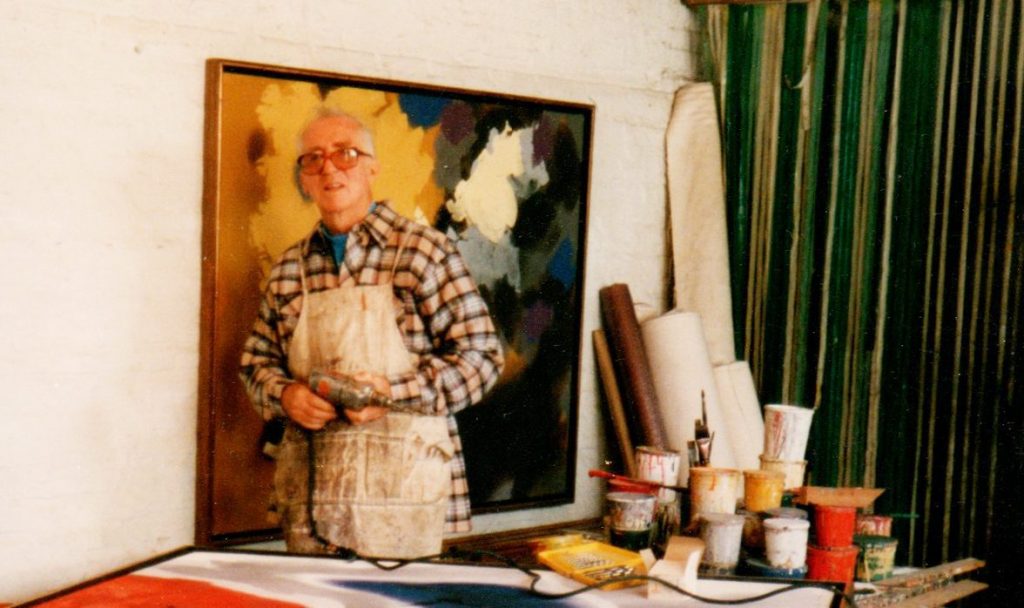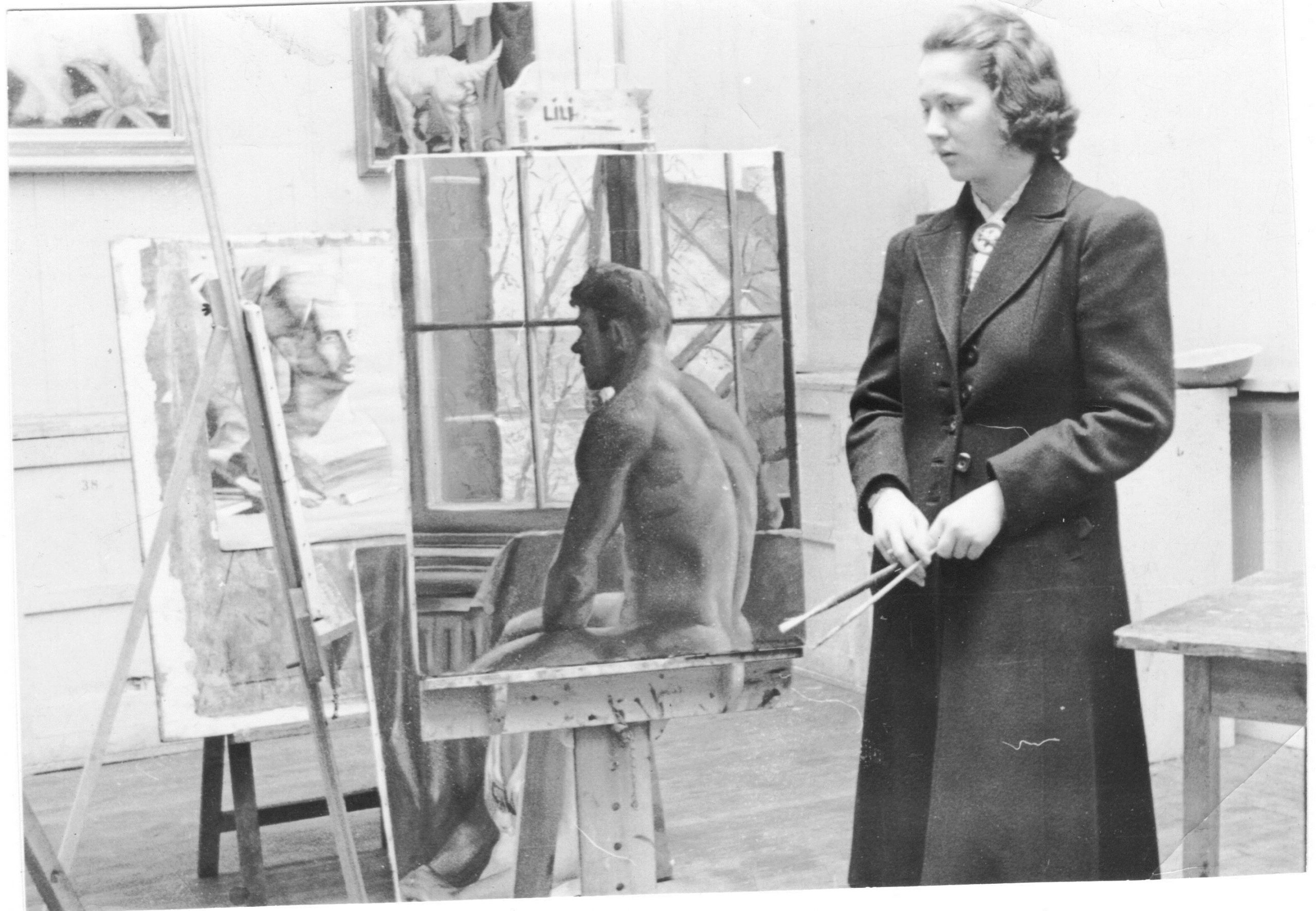Paul Emile Fontaine, (1913-1996)

Paul Emile Fontaine, was an abstract-Expressionist, color-field painter. He married fellow art student, Virginia Hammersmith Fontaine (1915-1991) and resided in postwar Germany and Mexico during the height of Modernism.
-
1913, June 21
Paul Fontaine is Born
Paul Emile Fontaine was born in 1913 in Worcester, Massachusetts to Elzear and Mary Fontaine, both of French Canadian descent. Fontaine had two brothers, Russell and Leo Fontaine, both younger.
-
1932-1935
Paul attends Worcester Art Museum School
Paul Fontaine was early on encouraged to be a painter, deciding to pursue this artistic path as a teenager. He was enrolled at the Worcester Art Museum School in Worcester, MA following completion of high school, from 1932 until he graduated in 1935.
-
1935
Paul graduates from Worcester Art Museum School
Fontaine graduated in 1935, and followed his studies with a six-month term in the Civilian Conservation Corps.
-
1936
Paul painted WPA murals
Paul Fontaine worked as a Works Progress Administration (or Section of Fine Arts, US Treasury) painter in Springfield, Massachusetts, painting murals in the city’s Post Office under Umberto Romano. Like many WPA murals, these contained images of Springfield and Massachusetts history in a bold, proletarian style, full of expressive movement and hard edges. In six panels, these murals now decorate Springfield’s federal building.
-
1938-1940
Paul attends Yale with Scholarships
Paul Fontaine was encouraged to continue his studies at Yale’s prestigious art school. Fontaine began at Yale in 1938 and graduated among the top of his class in 1940. Fontaine was awarded the Winchester Wirt Traveling Fellowship the same year, but due to wartime exigencies, chose instead to study and paint in the Caribbean.
-
1940
Paul Marries Virginia Hammersmith Fontaine

Paul Fontaine married fellow Yale art student, Virginia Hammersmith in 1940. Virginia was trained as a painter at Yale but did not graduate, and she became a major force in Paul’s subsequent creative activities.
-
1940
Fontaines went to the British Virgin Islands
Following their marriage the Fontaines went to the British Virgin Islands, primarily Tortola, on Paul’s fellowship, where he first began to extensively explore abstract forms in his watercolors. Meanwhile, Virginia Fontaine was a skilled photographer, regular diarist and frequent documenter of their lives together. Thus, experiences in the Virgin Islands were noted in both her pictures and words.
-
1941
The Fontaines return to Worcester
The Fontaines returned to Worcester in 1941, where Paul held a factory job and painted regularly, successfully submitting a number of watercolors for governmental tours. He also founded the Worcester Artists Group with Herbert Barnett, showed in Boston at the Grace Horn Galleries, and built a studio by hand behind his mother’s house, known as “Rocky Tor.” Paul Fontaine was drafted in 1943 and sent to Italy where he worked as an illustrator, also painting commissions for the US Army and Red Cross. Fontaine frequently painted semiabstract watercolors of the Italian countryside, maintaining his commitment to a career as an artist.
-
1943
Paul & Virginia's first child
The Fontaines’ first daughter, Carol, was born in 1943 in Worcester, MA.
-
1945-1953
Paul works for the Army
Starting in 1945, Paul worked as an Army cartographer in Paris, finally settling in Frankfurt as the graphic director for the Army’s regional headquarters. There, his work included posters and brochures. Paul stayed in this position until 1953, which allowed him the opportunity to live in Frankfurt as the city and its artistic community were rebuilt.
-
Virginia builds artist community in Frankfurt
The Fontaines’ apartment in Frankfurt soon became noted for its continual parade of artists, writers, art dealers and musicians, for Virginia Fontaine made their home into a place where artists could meet, share ideas and get to know one another in postwar Frankfurt. Her goal was not only community building, but to introduce Paul to European artists and bring him into the artistic circle.
-
1947
From 1947 onward, Paul Fontaine remained committed to exploring the abstract in his art, with increasingly large canvases and defiantly non-representational forms in oil, watercolor and acrylic paint, often with bold areas of color and naturalistic hues. For the next 23 years, Virginia was also committed to the success of Paul Fontaine as an artist. She steadfastly continued to introduce him to fellow artists and to curators and galleries, earning him frequent shows in Europe and, occasionally, the United States.
-
Late 1940's
US exhibition
During the late 1940s, Paul’s Italian watercolors also toured to acclaim in the United States in an exhibition organized by Virginia Fontaine that brought his work to Milwaukee and Ripon, WI; Kalamazoo, MI; Bloomington, IN; and Boston, MA.
-
1948
Paul & Virginia's second child
In 1948, the Fontaines’ second daughter, Eugenie (Paula), was born in Frankfurt.
-
1953
Paul becomes the art director for the "Stars and Stripes"
In 1953, the Fontaines moved to Darmstadt, where Paul became the art director for "Stars and Stripes", the Armed Forces European circular.
-
1956
Paul & Virginia's third child
The Fontaines’ third daughter Claudia was born in Darmstadt in 1956.
-
Virginia focuses on curation and photojournalism
During this period, Virginia began to focus more on her own work, which included curating and photography. At the request of Gordon Gilkey, the print curator for Oregon State University at Corvallis and former Adjutant General in charge of salvaging looted European art, she single-handedly curated and procured prints for an exhibition of contemporary German prints in 1963. She was also the translator for the first definitive work on Hans Hartung published by Ottomar Domnick who was a major collector of contemporary works from that time period. In addition, she photographed and was self-appointed publicist for the famed Mary Wigman modern dance company and opera star Bruni Falcon.
-
1970s
Paul retires and The Fontaines move to Guadalajara, Mexico
The Fontaines moved to Guadalajara, Mexico, following Paul Fontaine’s retirement. During his time in Mexico, the colors of his paintings became bolder, his forms gauzier and his canvases larger. He showed at the University of Colima, Jalisco, Mex. (1970) and, because he found Mexican culture more favorable, was able to represent himself to curators and galleries there.
-
1991
Virginia dies at age 75
Following the death of Virginia in 1991 at age 75.
-
1996
Paul dies at age 82 in Austin, TX.
Paul moved to Austin, Texas to be nearer to his daughters. He died in 1996 at age 82.